Ask an experienced Magic player what they think of the original Ixalan Limited environment, and you’ll likely be answered with eye rolls and groans. Although the setting was fantastic, the draft strategies were overly focused on one of four creature types: Merfolk, Vampires, Dinosaurs, and Pirates. The result was a draft that felt on rails, and the issue was only exacerbated once players discovered that one of the creature types was far better than the others.
But all of that was waaaaaaay back in 2017 - literally a million years ago. Ask an experienced Magic player what they think of Limited environments post-Ixalan, and the honest ones will crow that we are in a golden age of gameplay and fun. The Lost Caverns of Ixalan looks to continue this hot streak by embracing the popular setting while learning from the design mistakes of the past. The typal themes are gone; in their stead is an adventure asking players to descend into the dark crevices of the plane, searching for treasures while using all their desperate ingenuity to craft tools needed to survive the many dangers in the depths.
Mechanics and Themes
Descend X / Descended / Fathomless Descent



These three terms - puzzlingly similar yet different - all refer to the same conceptual space: the idea that you want permanent cards in your graveyard. A card with Descend X (in LCI X can be 4 or 8) gains a benefit if you have X permanents in your graveyard; Basking Capybara turns from a defensive creature to an offensive threat. A card with Descended will have a trigger if you place a permanent card into your graveyard (note that tokens do not count); Enterprising Scallywag makes you a Treasure. A card with Formless Descent cares about the number of permanents in your graveyard; Chupacabra Echo’s -X/-X effect dramatically increases in potency.
It’s possible to power these mechanics simply through the normal wear and tear of a Limited battle. However what you really want to do is take advantage of the copious self-mill effects in the set. Win that race, and you’ll win a huge advantage over your opponent.
Craft


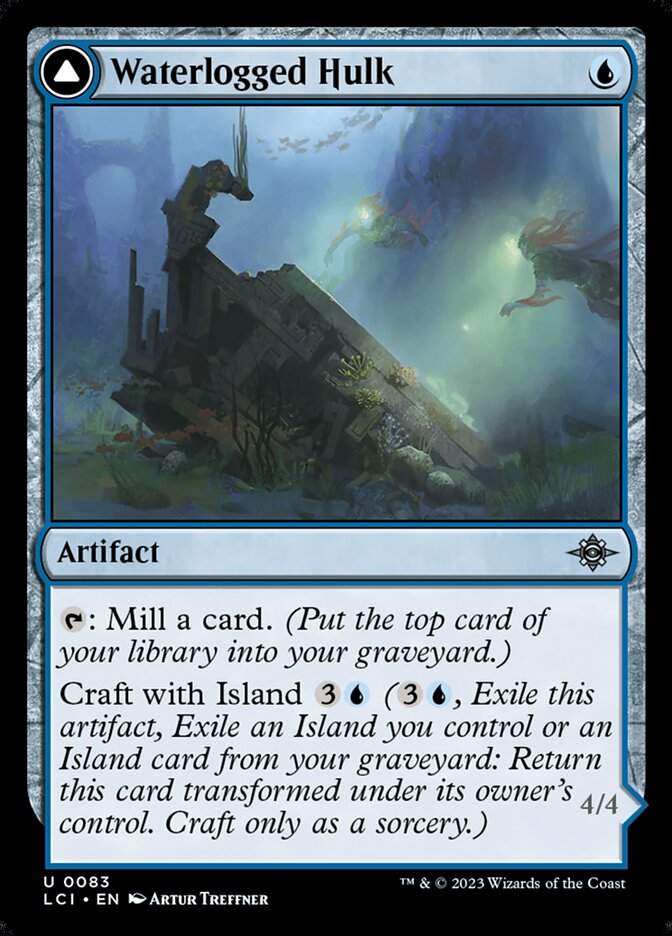

Craft is a keyword found on some artifacts, all of which are double-faced. Artifacts that have “Craft with X” can be transformed at sorcery speed by paying a two-fold price: a mana cost, and the exiling of X permanents you control from the battlefield or your graveyard (with the graveyard usually being preferable, of course). The permanent cost can vary from artifacts to Islands to Dinosaurs, and more. Note that some cards with Craft care about the cards exiled, so make sure to keep track of those!
Craft might feel like card disadvantage, but note that you’re essentially getting two spell effects in one card. For example, Clay-Fired Bricks // Cosmium Kiln starts as a low cost way to ensure you make your land drops, and flips into two cheap creatures that come with a strong anthem effect. Waterlogged Hulk // Watertight Gondola begins as a cheap self-mill effect before becoming a powerful vehicle. Just keep in mind that it may take a long time for you to be able to activate a Craft ability.
Discover

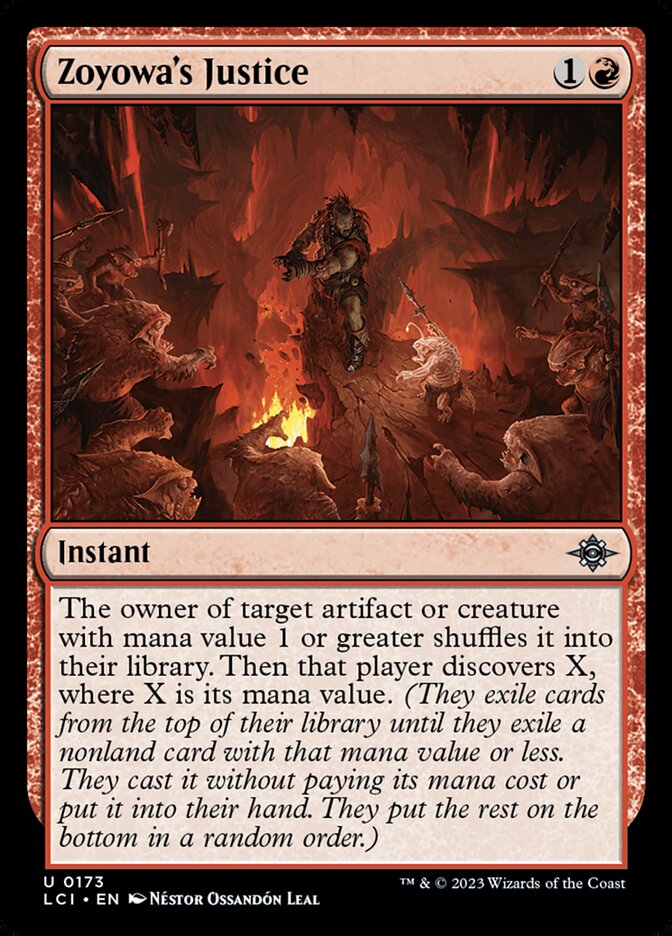
If you love Bloodbraid Elf and Shardless Agent (and free Rhinos), you’ll love Discover! Billed as a “fixed Cascade”, Discover X asks you to flip through the top of your deck until you find a card with mana value X or less. Then you can either cast that card for free, or put it into your hand. Discover effects can be invoked in a variety of ways: a death trigger on Primordial Gnawer, or simply by casting a spell like Zoyowa’s Justice.
The important thing to remember about Discover is that you always get a card, and you’ll often even get to cast that card for free. Any card with Discover contains inherent card advantage, and that’s pretty great.
Explore ( Map )


The popular mechanic from Ixalan returns, and remains an excellent way to search for lands while potentially dumping useless cards into your graveyard. Explore can be found on a variety of card types, from creatures to sorceries to Equipment such as Glowcap Lantern. New to LCI is the Map artifact token, which gives you the opportunity to Explore at a (sorcery speed) time of your choosing. Again, Map tokens are created by a variety of card types: creatures such as Spyglass Siren, instants, and more.
It’s worth emphasizing that while Explore and Map tokens may seem like nothing more than nostalgic callbacks to Ixalan, they actually serve as strong glue mechanics for a host of other mechanics and various archetypes. Do not sleep on these cards.
Caves



Well, you can’t have caverns without caves, and so a new Land subtype is born. A cycle of common Cave lands such as Hidden Necropolis give players additional land value; but the true payoff comes from various cards that care about the number of Caves you have in play plus the number you have in your graveyard (tying in nicely with Descend mechanics). For example, Cavernous Maw can exert additional pressure on your opponent; more dramatically, with judicious planning Calamitous Cave-In can act as an unbalanced board wipe that leaves your big creatures alive.
Archetypes
White / Blue: Artifacts ( Control )



“Mid-Range” may be a stretch here, considering White/Blue’s signpost uncommon has a Crafting cost of seven mana. But the front face of - Master’s Guide-Mural - creates an effective 4/4 body at a very fair price, and it’ll likely buy you the time you need to reach seven mana, at which point the back face - Master’s Maufactory - grants you an endless stream of value. You’ll need other ways to survive to the late game of course, and both Oteclan Landmark // Oteclan Levitator and Inverted Iceberg // Iceberg Titan give you classic control tools to do so. Their front side gives you cheap card selection or card draw, while their flip sides grant you nice defensive creatures that are also capable of eventually winning you the game.
White / Black: Sacrifice ( Mid-Range )



There may not be a Vampire typal theme in LCI, but the spirit of that theme lives on in White/Black’s sacrifice archetype. Bartolomé del Presidio is one of the best sacrifice enablers printed in a long time: free, instant speed, and unlimited as long as you have the requisite cannon fodder. Good candidates for cannon fodder include Market Gnome (which draws you a card) and Synapse Necromage (which gives you two more pieces of sacrifice bait). But how do you ultimately win the game? Sacrifice decks usually have a go-wide component by necessity, so I’d plan on building up an overwhelming board that wins through sheer weight or a game-ending mass pump effect.
Blue / Black: Descend ( Control )


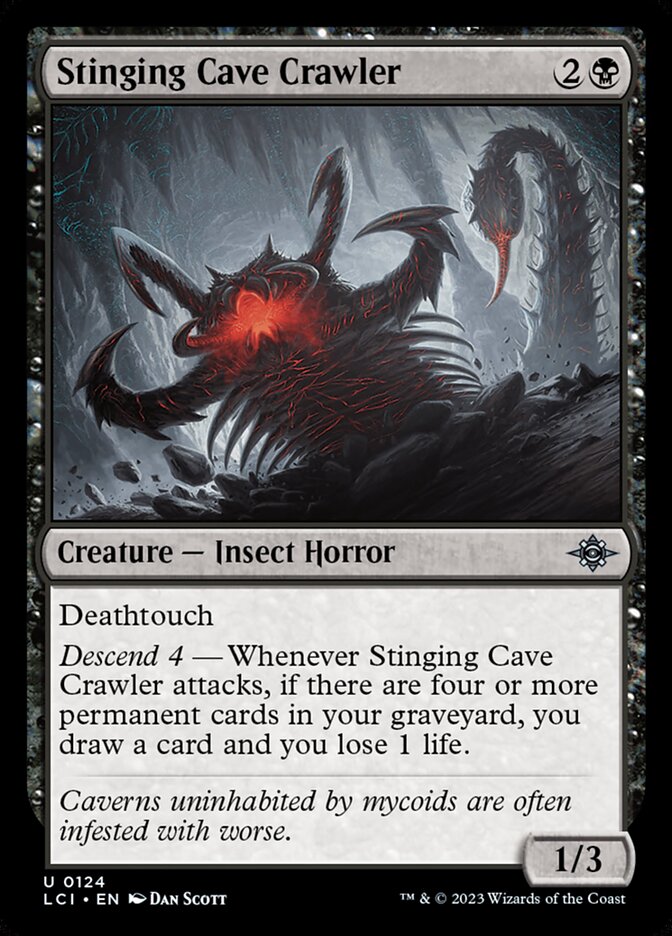
Uchbenbak, the Great Mistake is anything but: a fantastically costed beater with two extremely useful combat keywords. But its the rest of its text that reveals what Blue/Black wants to do - fill the graveyard in order to gain slow but inevitable value. Confounding Riddle is excellent for this archetype, giving you the choice between a counterspell and a card selection spell that also fills up your graveyard. Of course that may not be enough to help you survive an onslaught from a more aggressive deck. That’s why you’ll also want creatures such as Stinging Cave Crawler: a well-costed defensive creature with deathtouch that can turn into a source of card advantage once you’ve stabilized the board.
Blue / Red: Artifact ( Aggro )



Sometimes you want to be slow and deliberate with your artifacts, and sometimes you want to just dump them all out on the board. LCI’s Blue/Red archetype embraces the latter, as evidenced by its two mana signpost uncommon: Captain Storm, Cosmium Raider. This legendary gets out quick and buffs your board quick - as long as you find artifacts to drop on the battlefield. You can also take to the skies with Oaken Siren, who acts as both an evasive threat and a method for ramping out your artifacts. This creature may not do a ton of damage, but the front side of Dowsing Device // Geode Grotto makes them a little more effective - and the back side can end the game in one explosive hit.
Black / Red: Descended ( Aggro )



Black/Red decks are typically quite aggressive, and a Descended archetype that wants you to throw things into the graveyard feels like it pairs nicely with the color pair. But in LCI you’ll want to be a little more protective of your creatures than usual; after all, Zoyowa Lava-Tongue won’t be able to trigger its powerful ability if it’s splattered dead in your graveyard. For that reason, it’ll be convenient to have ways to trigger Descended without throwing your creatures into your graveyard. Screaming Phantom is ideal: an evasive threat that does the job quite nicely. You’ll have a harder time finding Red cards that naturally trigger Descended (although there are a few such as Child of the Volcano that gain bonuses when you do so). Just remember that this archetype is primarily about aggression, and you won’t go wrong if you just throw in a bunch of aggressive Red threats.
Black / Green: Descend ( Mid-Range )



What’s the difference between a mid-range Descend strategy and a control one? Well, the answer is simple: Akawalli, the Seething Tower has Descend 4 *and* Descend 8, while the Blue/Black signpost uncommon only has Descend 8. That means this archetype can get off and running a little bit faster, and hopefully establish its advantage earlier in the game. Once it does so, early two drops such as Echo of Dusk become far bigger problems for your opponent. And if the game runs long - as games against Black/Green often do - Coati Scavenger turns a stocked graveyard as a self-service buffet that allows you to select the right card for your needs.
Red / White: Go-Wide/Tap ( Aggro )



In LCI, Red/White once again embraces the power of dropping a ton of permanents. The twist here is that they won’t always be attacking, as cards like Caparocti Sunborn have valuable text that trigger if you tap your other creatures to power them up. Sunshot Militia’s ability might appear to be less potent - but note that it can be triggered multiple times, and I fully expect this common to win games. White’s role is a bit less aggressive but no less vital; Attentive Sunscribe is a needed early drop that also allows you to dig through your deck and find the right card to put you over the top.
Red / Green: Dinosaurs! ( Mid-Range )
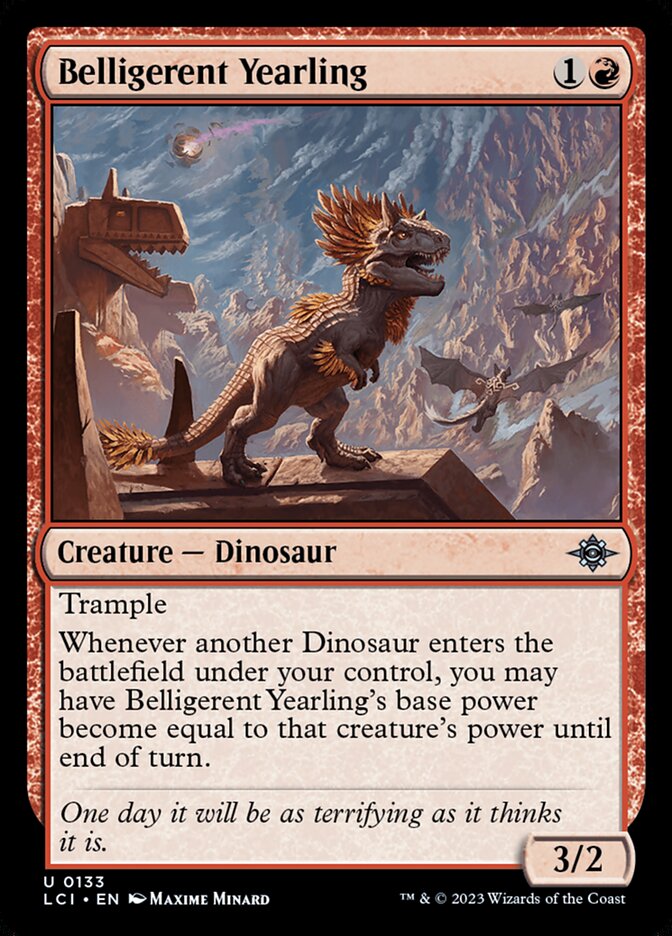


It turns out there’s actually one returning typal theme in LCI, and fortunately it’s Dinosaurs! This Red/Green archetype is charmingly simple and straightforward: drop above-rate creatures on curve. Itzquinth, Firstborn of Gishath is an excellent two drop with haste that also has the potential to act as a removal spell if you cast it late. Belligerent Yearling is another effective two drop that makes up for its lack of haste with its potential to hit really really hard in later turns. And Cavern Stomper? Oh, it’s “just” a 7/7 for six mana with substantial upside, and a creature that may be game ending on its own.
Green / White: +1/+1 Counters ( Mid-Range )



Someone reading Kutzil, Malamet Exemplar would probably (and understandably) assume that the Green/White archetype was all about strengthening creatures past their base power. But while it’s true that Kutzil works with all sorts of buffs, they’re one of only two cards that do so (with the other one being a mythic rare). What LCI does have is a ton of cards that give creatures +1/+1 counters - including the efficiently costed Ironpaw Aspirant, as well as literally every Explore card - and those counters are the real goal here. What’s the reward? Oh, just creatures that can attack through an opponent’s defenses and win the game. And if you’re nervous about your opponent’s removal spells, just stick in an Explorer’s Cache or two to ensure the flow of +1/+1 counters never ceases.
Green / Blue: Explore ( Mid-Range )


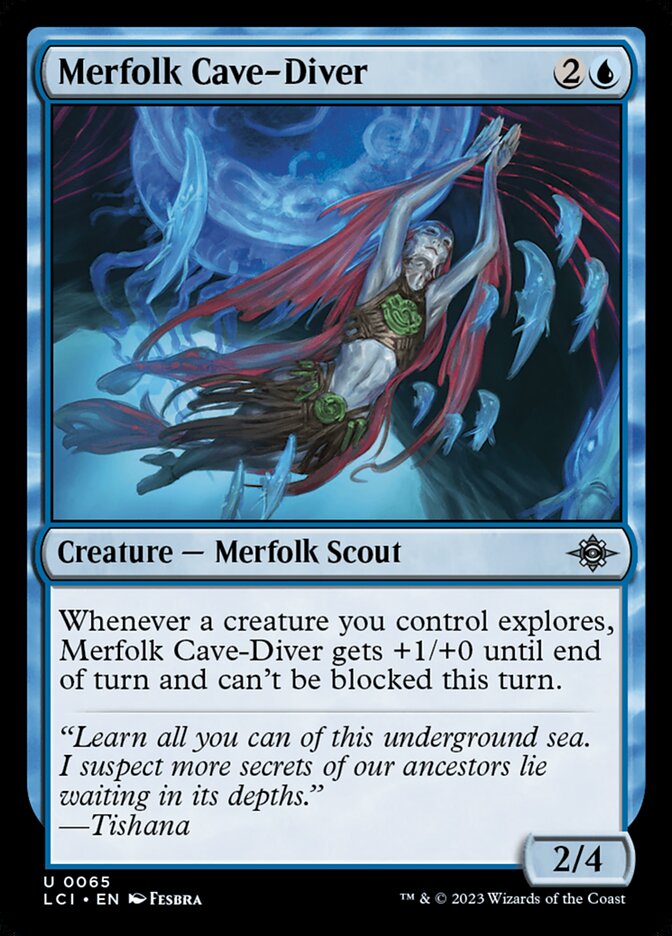
An Explore theme is a natural fit for Green/Blue, leaning into the archetype’s love of lands and buffs and decision making. Nicanzil, Current Conductor supercharges your Explore effects with either a ramp effect or an extra +1/+1 counter on Nicanzil. Twists and Turns // Mycoid Maze powers up Explore in a different way with a pre-Explore scry effect that makes it easier for you to find what you need - and later in the game the flip side will act as a steady source of creatures. Those creatures and counters are a good way to win the game, but if the board becomes stalled you can also rely on Merfolk Cave-Diver to sneak through for the victory.
Key Commons and Uncommons
White
Creatures



Malamet War Scribe: A mass pump effect is scary; one attached to a creature is deadly.
Oltec Archaeologists: In a different set this creature might only be okay. But LCI has artifact and sacrifice and self-mill themes, and that dramatically increases the value of their artifact retrieval ability.
Tinker’s Tote: This artifact will be a lynchpin “creature” in White decks because it slots so nicely into a variety of archetypes: artifacts, sacrifice, and go-wide. Don’t expect it to wheel.
Non-Creatures



Dusk Rose Reliquary: It may take a little work to make this artifact’s additional cost feel negligible. But I don’t think it’ll take a lot of work, and then you’ll be very happy with your one mana removal spell.
Petrify: A Pacifism effect is worse in a set with Craft and sacrifice effects and abilities that ask you to tap creatures. But it’s hard to argue with a two mana spell that severely limits any creature (or artifact).
Spring-Loaded Sawblades // Bladewheel Chariot: I’d be happy just playing the front side of this card as a cheap way to get rid of an attacker. Add the fact that it has the potential to transform into a relevant threat, and you have an incredible card.
Blue
Creatures



Council of Echoes: An evasive threat coupled with a bounce effect (that can reset a creature with +1/+1 counters or a flipped Craft card)? That’s strong.
River Herald Scout: This two mana creature will either draw you a card or grow into a 2/3 (that has the potential to fuel your graveyard). What’s not to like?
Waylaying Pirates: This creature will buy you time in a control deck and remove a blocker in a more aggressive deck (assuming you control an artifact, and why wouldn’t you?).
Non-Creatures



Brackish Blunder: A two mana bounce effect that also draws you a card is amazing. This isn’t quite that, but I think it’s not too far from it either.
Eaten by Piranhas: I’m usually not the biggest fan of these sorts of effects. But the addition of flash makes this a much better card, as it will often effectively act as a combat removal spell that also increases your Descend count.
Song of Stupefaction: A pseudo removal spell is often only pseudo good, but this one comes with a self-mill effect that can be critical for Blue archetypes.
Black
Creatures



Chupacabra Echo: This isn’t as good as Ravenous Chupacabra from Rivals of Ixalan, but it’s pretty close.
Skullcap Snail: A two mana creature that exiles a card out of an opponent’s hand is good. In this set It’s even better because its weak stats are mitigated by the many sacrifice and Craft mechanics.
Soulcoil Viper: This creature doesn’t do a ton on its own. But its potential for absolutely brutal reanimation shenanigans makes me want to give it a chance.
Non-Creatures



Bitter Triumph: This cheap unconditional removal spell does have a downside. But it’s one that I imagine I’d be quite willing to pay - and in some cases pitching a permanent into the graveyard may even be an upside.
Fanatical Offering: Have you ever sacrificed an artifact token to draw two cards at instant speed? Trust me - it feels great.
Join the Dead: Black’s premium four mana unconditional removal spell is only three mana and not quite unconditional. But it’s close enough.
Red
Creatures


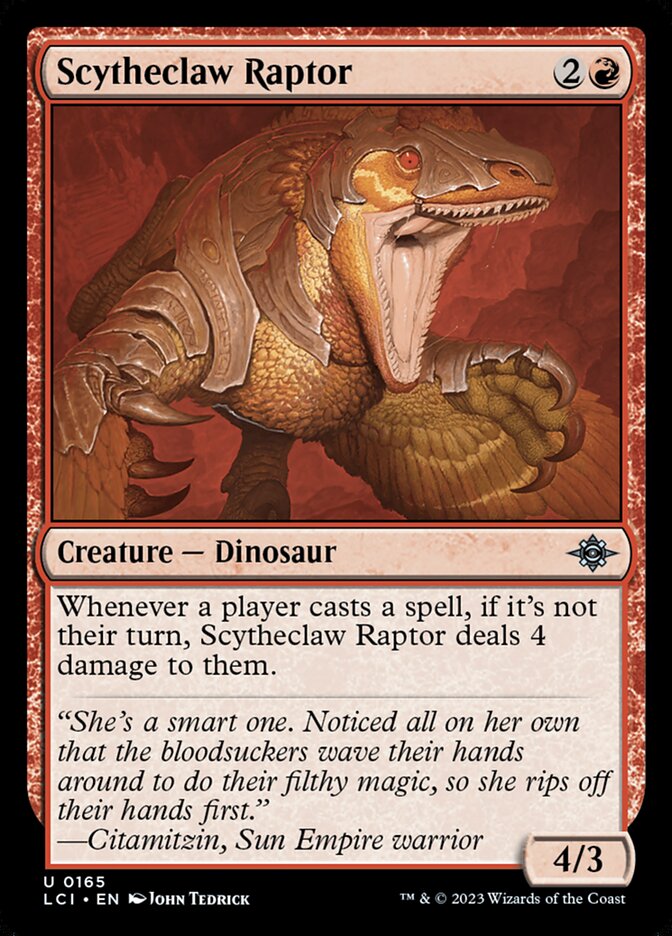
Geological Appraiser: Some might see this creature as a lesser Bloodbraid Elf. But Discover is not Cascade, and what I see is a creature that draws you a card that you can optionally cast for free.
Plundering Pirate: Red had a three mana creature that made Treasure last set, and it was honestly much better than I expected.
Scytheclaw Raptor: An above rate threat that also punishes your opponent’s instant and flash tricks? Heck yeah!
Non-Creatures



Abrade: A classic Red removal spell returns, and this time it’s even better since it’s in a set chock full of artifacts!
Dreadmaw’s Ire: +2/+2 and trample for an attacking creature isn’t bad, and the potential upside of destroying an artifact (in a set chock full of ‘em) is great.
Triumphant Chomp: One mana for two damage (to creatures) is a reasonable rate, even at sorcery speed. What makes this card good is the potential for it to be one mana for an excessive amount of damage (to creatures).
Green
Creatures



Colossadactyl: It’s hard to argue with these stats and keywords at that price.
Earthshaker Dreadmaw: It’ll take a little work to get some value out of this big guy. Actually it won’t, because a 6/6 with trample for six mana will win plenty of games on its own. The potential for drawing extra cards? That’s just pure gravy.
Thrashing Brontodon: A 3/4 for three mana is pretty good at offense early and defense late, and its ability to stymie a Craft card (or some other powerful artifact or enchantment) is ideal.
Non-Creatures
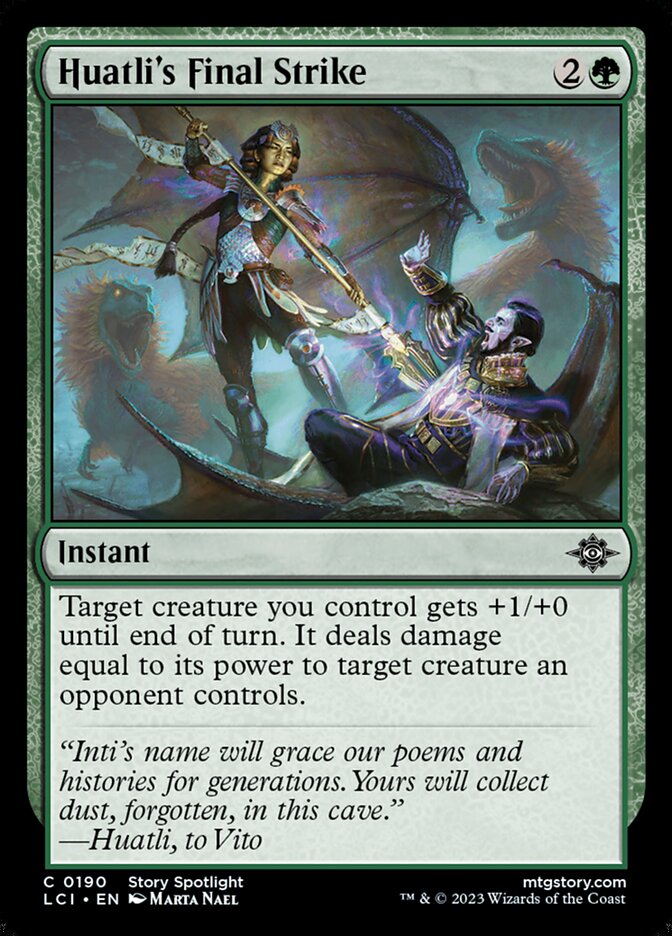


Huatli’s Final Strike: Green removal spells that depend on a creature always feel a little risky - a necessary evil. But an instant speed punch does a lot to mitigate those fears.
In the Presence of Ages: A fast Green dec won’t want this, but a slower one will love an instant that (potentially) draws two cards while filling your graveyard.
Malamet Battle Glyph: Can’t really argue with a one mana fight spell with upside.
Cards to Know
Mana Fixing
There’s a cycle of creatures that can be cycled for a matching basic land. The cycling cost isn’t free, but note that it’s another way to throw a permanent into the graveyard (at instant speed!)





There’s additional mana fixing, with surprisingly little in Green.
Red

Plundering Pirate: I don’t usually list Treasure makers, but I’m starting to believe that cards that are guaranteed to produce Treasure are reliable enough to count as mana fixing.
Green

Colorless



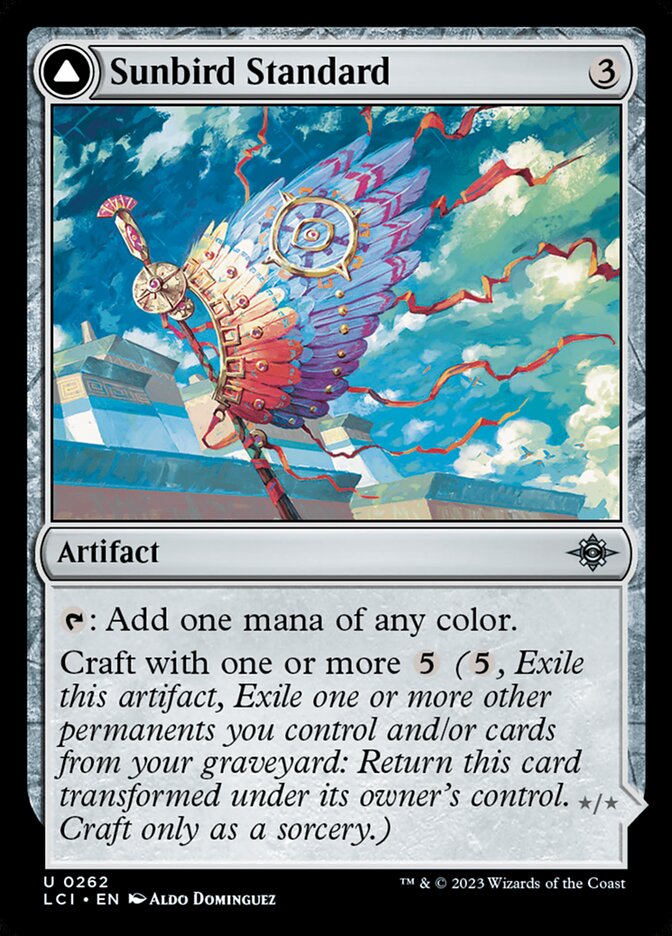



Compass Gnome: Note that this is especially good with Explore!
Reach
Admit it: you wouldn’t have known that a few of these creatures can block fliers.
Red

Green



Exile from Graveyard
Unsurprisingly, cards that can exile cards from your opponent’s graveyard are strong in a set with graveyard themes. Keep an eye out for these:
Colorless




Summation
Here’s what I’d keep in mind about The Lost Caverns of Ixalan.
- LCI is a synergy set, with many of its mechanics dependent upon achieving certain conditions. However the enablers for these mechanics are quite common, meaning it’s more important to focus on strong payoffs first. And if you see an individually powerful card, you can stuff it into your deck without worrying too much about the need for synergy.
- Explore is really good, and will incidentally enable everything from Descend to Craft to +1/+1 counters.
- The Cave theme isn’t as pronounced as Gates in Ravnica Allegiance or Defender in Dominaria United. But individual cards are still quite powerful, and it may be worth speculating on a Cave or two in the middle of a bland pack.
- The featured mechanics - Descend and Craft - are on the slower side, and require time to get going. But some archetypes in LCI are actually pretty fast; don’t sleep on the speed of artifacts or Dinosaurs or +1/+1 counters. Prepare accordingly.
- There is enough fixing to support three (or more) colors; more importantly, there are definitely synergistic reasons to draft Jeskai artifacts or Sultai Descend. I wouldn’t hesitate to be greedy with my picks.
Good luck!










